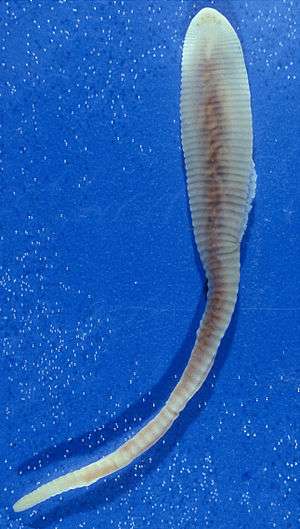Linguatula serrata
Linguatula serrata is a cosmopolitan zoonotic parasite, belonging to the tongueworm order Pentastomida. They are wormlike parasites of the respiratory systems of vertebrates. They live in the nasopharyngeal region of mammals. Cats, dogs, foxes, and other carnivores are normal hosts of this parasite. Apparently, almost any mammal is a potential intermediate host.
| Linguatula serrata | |
|---|---|
 | |
| Scientific classification | |
| Kingdom: | |
| Phylum: | |
| Subphylum: | |
| Class: | |
| Subclass: | |
| Order: | |
| Family: | Linguatulidae |
| Genus: | Linguatula |
| Species: | L. serrata |
| Binomial name | |
| Linguatula serrata (Fröhlich, 1789) | |
Morphology
The adult parasite is dorsoventrally flattened, tapering backwards resembling a vertebrate tongue, thus, inspiring the common name of "tongueworm."
Physical characteristics: males: 18–20 millimetres (0.71–0.79 in) in length, while the females are 80–120 mm (3.1–4.7 in).
Behavior and reproduction
Both male and females are required to mate for successful reproduction. Males choose to mate with females that are close to their own size. Females contain hundreds of thousands of eggs.
Epidemiology
Infection of Cairo dogs varies from male to female, with a ratio of 1.9:1 (58.97% and 30.77%, respectively). Prevalence of infection rate is higher during spring and summer (66.67%), compared during fall and winter, which constitutes 33.33% of the infection rate. The probable source of canine infections is infected lymph nodes of cattle, sheep, goats, and/or camels, which produce the symptoms of halzoun and the marrara syndrome in man when consumed raw .[1]
Geographic range
L. serrata can be found worldwide but especially in warm subtropical and temperate regions.
Life cycle
Adult L. serrata embed their forebody into the nasopharyngeal mucosa, feeding on blood and fluids. Females live at least two years and produce millions of eggs. Eggs exit the host in nasal secretion or, if swallowed, with feces. When swallowed by an intermediate host, the four-legged larvae (resembling a mite) hatch in the small intestine, penetrate the intestinal wall, and lodge in tissues, particularly in lungs, liver, and lymph nodes. The nymphal stage develops. When eaten by a definitive host, infective nymphs either attach in the upper digestive tract or quickly travel there from the stomach, reaching the nasopharynx. Females begin egg production in about six months.

Disease
Linguatulosis is a condition associated with the organism Linguatula serrata. More generally, linguatulosis can be considered a form of "pentastomiasis", which refers to all diseases caused by pentastomids, including porocephaliasis.[2]
This disease is often accidentally identified during autopsy because of its asymptomatic effect on the body.
References
- Galila M. Khalil (1970). "Incidence of Linguata serrata infection in Cairo mongrel dogs". Journal of Parasitology. 56 (3): 485. doi:10.2307/3277608. JSTOR 3277608.
- R. Heymons (1942). "Der Nasenwurm des Hundes (Linguatula serrata Froelich), seine Wirte und Beziehungen zur europäischen Tierwelt, seine Herkunft und praktische Bedeutung auf Grund unserer bisherigen Kenntnisse". Zeitschrift für Parasitenkunde. 12 (6): 607–638. doi:10.1007/BF02121635.